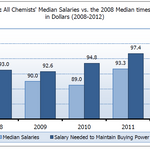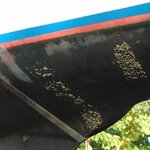Chemistry

A new drought-protecting chemical shows potential for crop protection during periods of dry weather.A research team led by Sean Cutler, a plant cell biologist at the University of California, Riverside, has found a new drought-protecting chemical that shows high potential for becoming a powerful tool for crop protection in the new world of extreme weather.
Named “quinabactin” by the researchers, the chemical mimics a naturally occurring stress hormone in plants that helps the plants cope with drought conditions.
All land plants have intricate water sensing and drought response systems that…

The American Chemical Society recently published its 2012 salary survey for Chemists and can be found here: http://www.acs.org/content/dam/acsorg/careers/salaries/surveys/salaries-2012.pdf
As Figuer 1 shows, the median salary for all (degree level) chemists took some serious hits during the recent recession:
Perhaps more importantly, by 2012 the median salary for Chemists was not only $1,300 less than 2008 but factoring in the effects of inflation the median salary for chemists was a full $7,900 less than in 2008.
Figure 2 breaks it down by degree level:
Chemists with bachelors degrees have…

Barnacles are a major problem for both small boats and large ships because they accumulate on the hulls and can reduce the fuel economy of a vessel by up to 40 per cent.
That means CO2 emissions rise accordingly.
Most marine organisms that attach themselves to hulls – for example mussels and algae – can easily be scraped off, but barnacles literally grow into the surface and form dense calcium deposits underneath the paint. The most common method used to prevent fouling is to mix the paint with a poisonous substance. The poison is then released slowly from the painted hull to discourage…

Could you make an ancient beer using nothing but ancient tools?
Probably, if you know how to make beer anyway. But would it be authentic ancient beer? Archaeologists and brewmasters have been trying to make just that kind, sparing no effort to replicate a 5,000-year-old Sumerian beer using nothing more complex than clay jugs and a wooden spoon.
It's the ultimate artisan brew.
And beer is important, not just to science (where it is vital) but to world culture - you can win any barroom debate on anthropology arguing that beer made agriculture important. And agriculture made…
Want to off someone but you are ethically against using anything made by Monsanto?
There is good news. Ricin is organic, a naturally occurring lectin (toxalbumin) made from from the castor oil plant Ricinus communis so you can use it in good conscience. Given the common nature of castor beans- the plants grow wild all over the place - and the fact that it was weaponized by the Canadian and US military in World War II but studied even as early as World War I, it's a surprise no one had used ricin to try and kill anyone a lot more before now, but it really only began to show up in 2003.(1) Yet…

How lifeless materials became organic molecules that are the bricks of animals and plants is a science question for the ages.
The secret of a reaction that has to do with the synthesis of complex organic matter before the origin of life. is now less secret, say researchers at the Max Planck Institut für Kohlenforschung. Since the 1960’s it has been well known that when concentrated hydrogen cyanide (HCN) is irradiated by UV light, it forms an imidazole intermediate that is a key substance for synthesis of nucleobases and nucleotides in abiotic environment. The way how UV radiation acts in…

Because government mandates and subsidies for ethanol have caused grain prices to increase, pig farmers have instead looked for alternatives. One of those is distillers dried grains with solubles (DDGS), a co-product of ethanol that has expanded along with that industry.
But it is an evolving feed and some believe that unsaturated fatty acids in distillers dried grains leads to increased oxidation, which affects texture, color, juiciness and the overall flavor of pork products, and therefore the shelf life. Some producers believe they can counteract that by feeding pigs…

By simply manipulating chemical gradients in a beaker of fluid, researchers have been able to create delicate flower structures - not at the scale of inches, but microns.
These minuscule sculptures don't resemble the cubic or jagged forms normally associated with crystals, though that's what they are. Rather, fields of carnations and marigolds seem to bloom from the surface of a submerged glass slide, assembling themselves a molecule at a time.
The precipitation of the crystals depends on a reaction of compounds that are diffusing through a liquid solution. The crystals grow…

Organic
chemists are regularly surrounded by chemicals and their smell. Colour is not
the only characteristic by which we recognize compounds. Too often, it is their
odor that allows us know that they are around. My relationship with strong,
pungent, fishy, offending odors began in the early years of undergraduate lab
training. This is not true only for chemists, but also for them coming from
allied fields.
Odor is complex chemistry. One can come across various smelly
substances especially those emanating from the kitchen of every household. Odor
Chemistry is so complex that it took until…

The most powerful batteries on earth are only a few millimeters in size but a cellphone version can jump-start a dead car battery and then recharge the phone in the blink of an eye.
Led by Professor William P. King, researchers at the University of Illinois at Urbana-Champaign show that the new microbatteries out-power even the best supercapacitors and could drive new applications in radio communications and compact electronics.
With currently available power sources, users have had to choose between power and energy. For applications that need a lot of power, like broadcasting a radio…